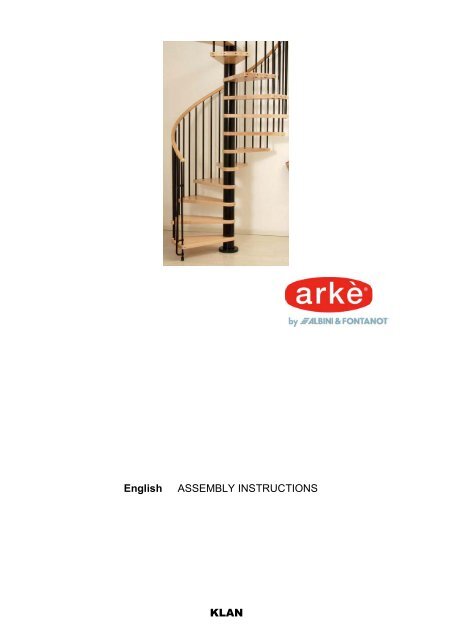Klan Assembly Instructions - Estairs
Klan Assembly Instructions - Estairs
Klan Assembly Instructions - Estairs
Create successful ePaper yourself
Turn your PDF publications into a flip-book with our unique Google optimized e-Paper software.
English ASSEMBLY INSTRUCTIONS<br />
KLAN
KLAN - www.arke.ws
English<br />
Before starting the assembly process, unpack all components of the staircase. Lay them out on a large surface and<br />
check the quantity of all the pieces, by consulting the table TAB.1 (A = Code, B = Quantity).<br />
Inside the staircase box you will also find a DVD which we suggest watching before proceeding to assemble.<br />
For the USA only: call the customer support line at 1-888 STAIRKT, should you have any case of need.<br />
Preliminary <strong>Assembly</strong><br />
1. Assemble the parts C24, C25 and B20 to the treads (L03) (fig. 2).<br />
2. Carefully measure the floor-to-floor height and determine the required number of spacers (D08) (TAB.2) and<br />
prepare them onto their proper spacer (D15) (TAB2)<br />
3. Assemble the parts C63, C65, C66 onto the baluster (C03), by using the part B68 (fig. 3).<br />
4. Assemble the base G03, B17 and B46 (fig. 1).<br />
<strong>Assembly</strong><br />
5. Determine and mark on the floor the centre of the opening, then position the base (G03+B17+B46) (fig. 4).<br />
6. Drill with drill bit Ø 14 and fix the base (G03+B17+B46) into the floor by means of the parts B13 (fig. 1).<br />
7. Screw the pole (G02) into the base (G03+B17+B46) (fig. 1).<br />
8. Insert the base plate cover (D12) into the pole (G02) (fig. 5).<br />
9. Insert the spacers (D08), then the shorter spacer (D14), the spacers (D08), the first tread (L03), the spacers<br />
D08), the spacer (D15), the spacers (D08) and another tread (L03) and so on Add alternatively the treads<br />
alternately one to the right and one to the left, so as to distribute the weight in a balanced way (fig. 5).<br />
10. When you reach the end of the pole (G02), screw the part B47 on it, then add the second pole (G02) and continue<br />
with the stair assembly (fig. 5)<br />
11. When you reach the end of the pole (G02), screw on it the part B46 and the part G01. (Screw the part G01, until<br />
its upper end sticks out approximately 15cm (6’’) from the stair height (fig. 6). Continue adding the treads, by<br />
using the part D01 inserted into the tread (L03).<br />
12. Finally add the stair landing (E02). After having chosen the stair rotation (fig. 7), position the landing (E02) with<br />
the small hole (which is needed for the baluster passage (C03)) on the arrival side of the treads (L03) (fig. 8)<br />
Cut the landing (E02), if necessary, in relation to the floor opening.<br />
13. Insert the parts B05, B04 and screw the part B03 sufficiently (fig. 1) but keeping in mind that the treads still have<br />
to be rotated (fig. 1).<br />
Fitting of the Landing<br />
14. Approach the part F12 to the floor. Determine the position, maintaining a distance of about 15cm (6”) from the<br />
external side of the landing (E02), pierce with drill bit Ø 14 and fix securely by using the part B13 (fig. 1).<br />
15. Fix the parts F12 to the landing (E02), by using the parts C58 (pierce the landing (E02) with the drill bit Ø 5.<br />
16. Position the parts B95.<br />
<strong>Assembly</strong> of the Railing<br />
17. Spread-out the treads (L03) fan-like. It is now possible to use the stair.<br />
18. Starting from the landing (E02), insert the longer railing balusters (C03), that build the connection between the<br />
treads (L03). Keep the balusters (C03) with the part C63 and the pierced part to the top (fig. 8). Tighten only the<br />
part B20of the lower tread (fig. 2).<br />
19. Check very carefully the vertical position of the inserted balusters C03. This control is very important for insuring<br />
the best results.<br />
20. Tighten securely the part B03 (fig. 8).<br />
21. Tighten securely the part B02 of the upper tread (fig. 2).<br />
22. Check once more the vertical position of the railing balusters (C03) and, if necessary, correct it, by repeating the<br />
previous operations.<br />
23. Position the first baluster (C03). Cut one long baluster (C03) to obtain the same size as all others you assembled<br />
previously.<br />
24. Fix into the floor in relation to the first baluster (C03), the part F01, by piercing with the drill bit Ø 8. Use the parts<br />
C58, B12, B83 and B02 (fig. 1). Then assemble the reinforcing part (F07).<br />
25. Find the handrail piece not marked in red colour (A13) and the one marked in red colour(A14) which will be used<br />
for the railing of the landing (E02) (fig. 9).<br />
4 - kl<br />
klan by arkè
26. Start to model the handrail pieces (A13) not marked in red colour, trying to give it a shape that corresponds the<br />
nearest possible to the curve of the staircase (fig. 1).<br />
27. Beginning from the baluster (C03) on the landing (E02), start to fasten the handrail (A13),that you have already<br />
slightly bent in the previous operation. Use the parts C64 together with the screw driver. Warning: position the<br />
join line of the handrail covering downwards.<br />
28. Connect all other handrail pieces (A13), by screwing, glueing and shaping them. Use the parts B33 and D35.<br />
Position the thickest part of item D35 so it faces outwards.<br />
29. When you reach the first baluster (C03) at the bottom of the stair, cut the excess piece of the handrail with a<br />
hacksaw.<br />
30. Complete the handrail (A13) by assembling the part A12. Use the parts C64 and the glue (X01) (fig. 1).<br />
31. Insert all remaining railing balusters into the treads (L03), tighten the part B20 and fix to the handrail (A13), paying<br />
careful attention to the vertical position. (for the stairs with a diameter larger than 140cm(4’ 7 1/8”), we suggest<br />
that you first assemble the shorter balusters) (fig. 10). According to the geometrical characteristics of the staircase,<br />
the intermediate balusters may protrude from the lower part of the step, in which case we advise cutting them<br />
off level with the step to obtain a more attractive finish.<br />
32. Check again the regular shape of the handrail (A13) and, if necessary, correct it with a rubber hammer.<br />
33. Complete the railing assembly by fitting the parts B82 into the lower part of the balusters (C03) and the parts<br />
C19 into the lateral part of the treads (fig. 1).<br />
<strong>Assembly</strong> of the Balustrade<br />
34. Screw the baluster (C04) into the part G01 that sticks out from the landing (E02) (fig. 8).<br />
35. Set the parts F01, by using the parts C58, B83, B02 onto the landing (E02). Pierce with the drill bit Ø 5 the landing<br />
(E02), maintaining a similar distance between the holes as the one between the already assembled railing<br />
balusters (C03).<br />
36. Set the shorter balusters (C03) and tighten the part B02 (fig. 1)<br />
37. Fix the part A15 into the baluster (C04), by using the part B02 (fig. 1).<br />
38. Fix the handrail (A14) marked in red colour, using the parts C64 (fig. 1).<br />
39. In case there were walls around the stair well and on their position, it could be necessary to position one or two<br />
more balusters (C03) (fig. 10).<br />
40. In that case it is necessary to consider either the distance between all other balusters, or otherwise the distance<br />
from the wall. For the fixing it is suggested to pierce the landing (E02) with a drill bit Ø 5 and to use the fixing<br />
parts F01, C58, B83, B02. Whereas for the fixing into the floor it is suggested to pierce the floor with a drill bit<br />
Ø 12 and to use the parts F01, B02, B87 (fig. 11).In case it is necessary to join the landing baluster to the floormounted<br />
baluster, (Fig. 10), shape the handrails carefully, following the curves. If wrinkles should form on the<br />
inside of the handrails, this is not a defect. Rubbing the area energetically with a paper napkin (to generate heat)<br />
will cause them to disappear.<br />
Final <strong>Assembly</strong><br />
41. In order to re-inforce the staircase at the intermediate points, you must fix into the wall the parts F09 and connect<br />
them to the balusters (C03) by means of the parts F08. Pierce the wall with a drill bit Ø 8 and use the parts C50,<br />
C49, C58, B12 (fig. 12).<br />
We would be grateful, if you could send us any possible suggestion by visiting our Internet Site:<br />
www.arke.ws<br />
5 - kl<br />
klan by arkè
klan by arkè<br />
32 - kl<br />
TAB. 1<br />
A<br />
A12<br />
A13<br />
A14<br />
A15<br />
B02<br />
B03<br />
B04<br />
B05<br />
B12<br />
B13<br />
B17<br />
B20<br />
B33<br />
B46<br />
B47<br />
B82<br />
B83<br />
B95<br />
C03<br />
C04<br />
C19<br />
C23<br />
C24<br />
C25<br />
C49<br />
C50<br />
C58<br />
C63<br />
C64<br />
C65<br />
C66<br />
D01<br />
D08<br />
D12<br />
D14<br />
D15<br />
E02<br />
F01<br />
F07<br />
F08<br />
F09<br />
F12<br />
G01<br />
G02<br />
G03<br />
L03<br />
X01<br />
Ø 120<br />
3’ 11 1/4”<br />
3<br />
5<br />
1<br />
2<br />
13<br />
1<br />
1<br />
1<br />
7<br />
6<br />
1<br />
40<br />
6<br />
2<br />
1<br />
24<br />
9<br />
3<br />
33<br />
1<br />
40<br />
2<br />
77<br />
40<br />
2<br />
2<br />
21<br />
33<br />
73<br />
33<br />
33<br />
4<br />
119<br />
1<br />
1<br />
12<br />
1<br />
9<br />
1<br />
2<br />
2<br />
3<br />
1<br />
2<br />
1<br />
12<br />
1<br />
B<br />
Ø 140<br />
4’ 7 1/8”<br />
3<br />
5<br />
1<br />
2<br />
15<br />
1<br />
1<br />
1<br />
7<br />
6<br />
1<br />
52<br />
6<br />
2<br />
1<br />
36<br />
11<br />
3<br />
47<br />
1<br />
52<br />
2<br />
101<br />
52<br />
2<br />
2<br />
23<br />
47<br />
101<br />
47<br />
47<br />
6<br />
119<br />
1<br />
1<br />
12<br />
1<br />
11<br />
1<br />
2<br />
2<br />
3<br />
1<br />
2<br />
1<br />
12<br />
1<br />
Ø 160<br />
5’ 3”<br />
3<br />
5<br />
1<br />
2<br />
15<br />
1<br />
1<br />
1<br />
10<br />
6<br />
1<br />
52<br />
6<br />
2<br />
1<br />
36<br />
11<br />
3<br />
47<br />
1<br />
52<br />
2<br />
101<br />
52<br />
3<br />
3<br />
26<br />
47<br />
101<br />
47<br />
47<br />
6<br />
119<br />
1<br />
1<br />
12<br />
1<br />
11<br />
1<br />
3<br />
3<br />
3<br />
1<br />
2<br />
1<br />
12<br />
1
klan by arkè
klan by arkè
klan by arkè
klan by arkè
klan by arkè
klan by arkè
FIG. 2 FIG. 3<br />
FIG. 4 FIG. 5<br />
klan 39 by - arkè kl<br />
FIG. 6
FIG. 7<br />
klan by arkè
klan by arkè
klan by arkè
Albini & Fontanot S.p.A.<br />
ITALY – 47853 Cerasolo Ausa (Rimini) – Via P.P.Pasolini, 6 – Tel. +39 0541 906111 Fax. +39 0541 906125<br />
www.arke.ws<br />
D.U.M. 23/03/07







